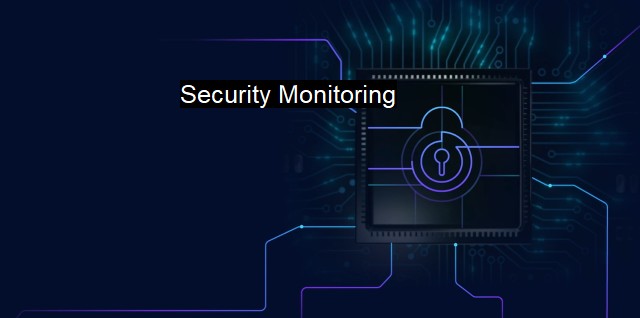What is Security Monitoring?
Securing Your Organization: The Importance of Security Monitoring and Threat Intelligence
"Security Monitoring" is an essential concept in the realm of cybersecurity and antivirus efforts. It pertains to the continuous supervision for distinct anomalies, threats, or infractions that may pose security risks inside a network environment or a system. Security monitoring implementations are intended to identify, neutralize, or even prevent digital threats.In a continually evolving digital environment, security monitoring plays a dual function. Firstly, it constantly observes various saved data sources or network access attempts with a dual intent to identify potential threats swiftly and to promptly respond to data or security breaches. Secondly, the planned operation component of security monitoring aims to predict patterns of foreshadowing threats or potential security risks based on continuous data feeds. With the assistance of refined algorithms and machine learning, these patterns can effectively support further improvements in cybersecurity measures.
"Security Monitoring" captures and collates data from a broad array of sources. Savvy interpretation of these amassed datasets helps entities to observe or predict security threats and vulnerabilities which can go unnoticed without proper detection and therefore, jeopardize the wholeness of the ecosystem. The diverse data sources include system logs, device status, network protocols, and applications among others.
To understand the importance of security monitoring in antivirus efforts, one must understand the damaging effects of viruses on software systems. Viruses and malware can fiercely damage systems, alter crucial programming code, steal sensitive data, or interrupt business operations. Antivirus software scan identifies, captures, and neutralizes these malicious threats.
Antivirus security monitoring operates by regularly scanning a system or network and cross-referencing the accessed files or suspicious software against a database of known threats. This vigilant monitoring can recognize established forms of malware as well as new variants, making it an essential dimension of an effective cybersecurity framework.
Security Monitoring relies upon an array of arduous strategies and state-of-the-art resources to ensure optimum security. These strategies include the installation of sensors in critical junctions to monitor suspicious activities, orchestration of security information and event management systems, deployment of penetration testing and vulnerability assessments, and the creation of sophisticated alert mechanisms.
It's important to mention that "Security Monitoring" isn't just about identifying potential threats; it incorporates response and remediation aspects too, which essentially happen right after a threat is identified. Utilizing real-time analysis, security monitoring can steer quick protective measures mitigating cyber threats thus reducing the intervals between compromise discovery and remediation.
The process is not just automated – human interpretation of security monitoring data is fundamental in applying intelligence and common sense to authentic alerts. Therefore, it ensures that both false positives (alerts that signify risk where there isn't one) and false negatives (missing an actual risk) are abated, providing a comprehensive security shield to any system.
"Security Monitoring" integrates a host of complex technology to protect digital assets from potential threats. This includes proactive identification of large-scale patterns revealing risk probabilities, promptly dealing with apparent threats, escalating incidences appropriately, and equipping teams with informational updates. It upholds the security health of an organization and guarantees that continuity of services is not disrupted. At the same time, it smoothens adaptation to new threat landscapes in cybersecurity and helps organizations ensure their digital fortitude.

Security Monitoring FAQs
What is security monitoring in cybersecurity?
Security monitoring in cybersecurity refers to the process of actively monitoring computer systems, networks, and applications to detect, prevent, and respond to potential security threats or attacks. Security monitoring is critical to maintaining a secure environment and protecting confidential data.What are the benefits of security monitoring in cybersecurity?
The benefits of security monitoring in cybersecurity include early detection and prevention of security threats, improved incident response times, reduced risk of data breaches, enhanced compliance with industry regulations, and increased visibility into network activity.What are the different types of security monitoring?
The different types of security monitoring in cybersecurity include network monitoring, endpoint monitoring, log monitoring, file integrity monitoring, and vulnerability scanning. Network monitoring involves monitoring network traffic for suspicious activity or unauthorized access attempts. Endpoint monitoring involves monitoring end-user devices, such as laptops and mobile devices, for malware or other security threats. Log monitoring involves analyzing system logs for security events or anomalies. File integrity monitoring involves monitoring changes made to critical files or directories. Vulnerability scanning involves scanning systems or applications for known vulnerabilities that could be exploited by attackers.What tools are used for security monitoring in cybersecurity?
There are several tools used for security monitoring in cybersecurity, including antivirus software, intrusion detection systems (IDS), security information and event management (SIEM) tools, network packet analyzers, and vulnerability scanners. Antivirus software helps prevent and detect malware on endpoints. IDS systems detect and alert on suspicious network activity. SIEM tools aggregate and centralize security logs and alerts from various sources. Network packet analyzers capture and analyze network traffic. Vulnerability scanners scan systems and applications for known vulnerabilities.| | A | | | B | | | C | | | D | | | E | | | F | | | G | | | H | | | I | | | J | | | K | | | L | | | M | |
| | N | | | O | | | P | | | Q | | | R | | | S | | | T | | | U | | | V | | | W | | | X | | | Y | | | Z | |
| | 1 | | | 2 | | | 3 | | | 4 | | | 7 | | | 8 | | |||||||